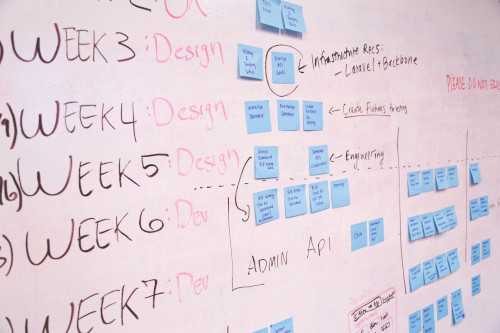
If you’re buying into web or mobile development for the first time, the process can seem, shall we say, overwhelming at times. Often, the customer thinks that he doesn’t have to understand the complicated story and process either. However, the developers already know what they are doing. Unfortunately, by approaching the matter in this way, the desired result may not be obtained. We’ve put together a list of the most common mistakes when buying a development service so you can avoid them.
1. Inadequate strategic planning
Any development project is at risk if the company is not clear on exactly what they want to order. Since the agile methodology allows for easy implementation of changes in the project, it can be thought that initial planning is not necessary. But that’s not quite the case. Of course, priorities and logic often have to be adjusted during the process, but preliminary analysis and planning are always needed.
2. Unclear definition of project scope
It is very important that both the client and the development team have a clear idea of the requirements, the overall scope of the project, the expected schedule, the elements or functionalities to be delivered, etc.
The development team should have a clear picture of the following issues:
- What is the purpose of the project?
- What will the team’s workflow be like?
- Does the client have enough time to contribute to this project?
- On which platforms must the application work?
- Do you have all the content you need?
3. There are no clear expectations
Without a defined goal, the developer does not know how to do exactly what you envision, and it is not possible to understand exactly what you need.
In addition to clear expectations, you should also think about clear measurement. Especially when you’re just starting to work with a service provider, it’s important to define how you’re going to measure whether the collaboration is working or not.
4. If I order in, there is no need for a project manager
Although they can be a developer at the same time, they are usually a project manager assigned to work by the service provider. It is beneficial if there is also a dedicated person or team from the client side who is responsible for all communication and keeps an eye on the progress and time frame.
While it is sometimes necessary to put out fires, it is important for both parties to find project people who are committed to long-term success rather than providing quick patches.
5. Communication barriers
The team may consist of top specialists, but it will not bring the desired results if there is no effective communication. Team collaboration drives creative thinking and effective brainstorming. This allows approaching business and technical tasks from multiple angles.
There is always a lot of information in software projects. Therefore, it is important that team communication is effective and timely. If teammates don’t share their knowledge or steps, some members won’t be able to make valuable contributions at the right time. This may mean that the development will not be completed on time. Team collaboration accelerates product development and allows products or innovations to come to market faster, as employees work together on challenges.
Regular communication helps to keep a common vision and direction in mind. When team members don’t understand the big picture and the importance and contribution of their work, it can lower motivation and morale, which in turn can lead to more mistakes. This in turn means that it takes more time to test the product and for developers to rewrite the code.
Daily or weekly communication ensures that everyone involved knows enough about both the big picture and what they are responsible for. This allows each team member to operate efficiently and saves time, money and effort.
It is good to agree on regular ways and channels of communication. For larger projects, utilizing collaborative software like Atlassian products (such as Jira and Confluence), along with video calls, meetings, and daily or weekly stand-ups, are helpful.
6. Lack of trust and openness
The customers of the development service may find themselves in a defensive position when choosing a cooperation partner, but trust and openness are prerequisites for excellent and effective collaboration. Of course, this applies to both parties. The development partner must also be transparent and open in its work.
The more precisely the development partner knows what your challenges and pain points are, the more precisely they can create a solution that you really need, not what you asked for.
That doesn’t mean you have to blindly trust right away. To test reliability, research the partner’s previous work and experience from previous clients.
A fixed price has its advantages, as it provides a sense of certainty when planning spending within a set budget. At the same time, it is important to ensure that flexibility is not sacrificed with a fixed project price.
7. Choosing a service provider primarily based on price
While price is certainly important, no offer should be judged by price alone, and different offers should be considered and compared.
Development definitely becomes an expense if you approach it as an expense. Investing in a poor tool can do more harm than good. However, considering the cost of the development as an investment in a better future, it will probably pay for itself in a reasonable amount of time.
There is a simple rule that you can’t get high-quality things cheaply. You get what you pay for.
If your goal is to grow your business, it pays to take quality seriously. Get to know the work done, read testimonials from previous customers and then make your choice. Find out with potential partners where costs can be cut and where it makes sense to pay a little more but achieve the best possible result.
8. Agreeing on a fixed price without a clear vision of what needs to be built
A fixed price has its advantages and we know that a fixed budget provides a sense of certainty. At the same time, it should be ensured that flexibility is not sacrificed with the negotiated price.
A fixed-price project is suitable if the customer has a detailed description of what the final solution should look like, and the customer can provide the technical details themselves.
If it does not exist yet, and the final solution is to be established with the help of a development partner, the fixed price would be hypothetical, since no one can accurately estimate the cost of the solutions, if it is not known in detail what needs to be built.
In such a situation, either the partner gives an estimate with a large buffer and the client overpays for the service, or the development partner suffers a loss. Either way, it’s not a great collaborative solution.
If your goal is to grow your business, it pays to take quality seriously. Get to know the work done, read testimonials from previous customers and then make your choice. Find out with potential partners where costs can be cut and where it makes sense to pay a little more but achieve the best possible result.
In summary
The best way to avoid mistakes when outsourcing software development projects is to be clear about things. Make sure both parties are ready to clearly communicate goals, desires, expectations and responsibilities, and to accept these commitments and responsibilities. Be honest with yourself and also with the development partner.







